My twitter pal Jessica read the earlier post on how to use a cider barm to make sourdough bread. Serendipity is a wonderful thing as Jessica was racking wine that day. So Jessica contacted me on Twitter…
And so Jessica did. I’m very grateful to Jessica who sent the pictures she took and the recipe notes for her bread so I may share it more widely.
Wine barm sourdough bread recipe
Ingredients
Poolish
447g wine ferment (from courgette & sultana wine)
200g flour
2tbsp honey
Dough
Poolish from above
400g flour
6g salt
Method
Mix up the ingredients for the poolish in the evening before you want to bake. Leave at room temperature overnight for 9 hours or so.
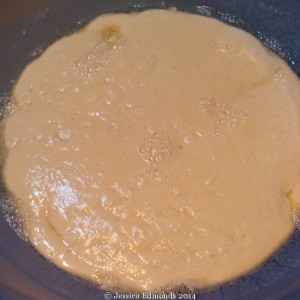
Then add the poolish to the remaining flour and the salt and mix well.
Jessica left the dough to bulk prove and gave a stretch and fold. See the first video in my how to make sourdough post.

After the bulk prove, Jessica shaped the bread and put it into a floured banneton to prove.
Once proved, Jessica baked the bread on a hot stone at Gas 7 (220°C) for approx 50 minutes without any steam.
Results
Here’s Jessica’s view of what she’d baked.
Open crumb, but a slightly sticky glutinous texture that didn’t dry out after a couple of days.
Crust similar to sourdough.
Taste sweet, nice but quite hard to describe.
Profile a little flat, dough felt resistive and gluten strong during kneading, but perhaps would have benefitted from a couple of stretch & folds at hourly intervals prior to going in the banneton.
Overall really pleased with the result: happy that elements of the wine-making process aren’t going to waste & will definitely do it again.
My thoughts
This is a very worthwhile experiment, I’m grateful to Jessica for sharing it with us.
I think that the ratio of water to dry ingredients seems quite high (at 75%). This makes a very wet dough which make it quite tricky to handle and more likely to produce the flat profile. I would like to try this with 390g of wine barm which is 65% of the dry ingredients.
I agree with Jessica that the dough could benefit from some more stretch and folds. It would be good to try 3 hourly stretch & folds in the bulk prove.
And aren’t Twitter and blogs a great way of sharing information, inspiring people to try new things and as a resource of collective knowledge?
Have you tried anything similar yourself? What do you think of Jessica’s experiment?

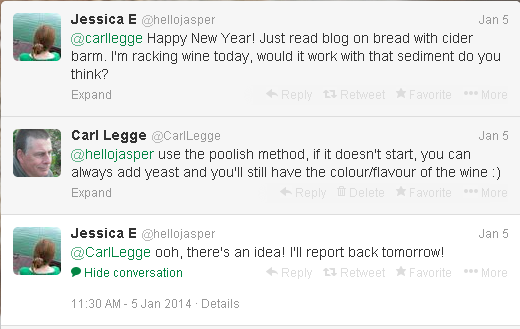
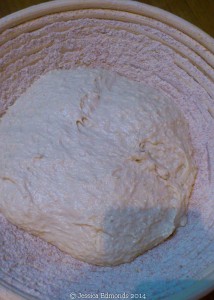
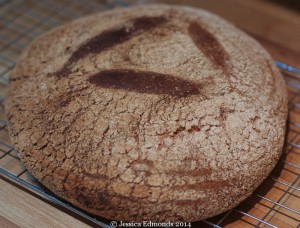
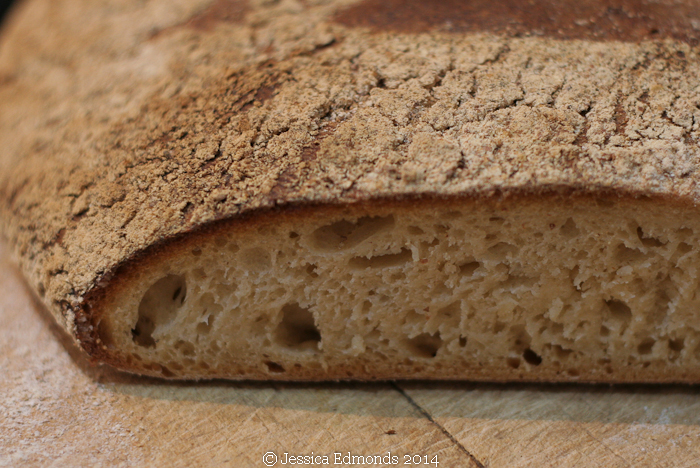
Comments
4 responses to “Wine barm bread”
[…] Wine barm bread […]
Great result Jessica. You’re right, it’s good to think that nothing from the fermentation process goes to waste. I’ve found that when using a high ish hydration like you did, cooking in a closed environment, like a dutch oven, transforms the water into steam better and helps inflate the bread thus preventing the texture being too sticky. But very well done on what you achieved; roll on the next fermentation and the next bake 🙂
lovely post Carl thanks for sharing
[…] twitter pal, Jessica, was inspired by this bread to make bread using a wine barm. See her Wine Barm Sourdough […]